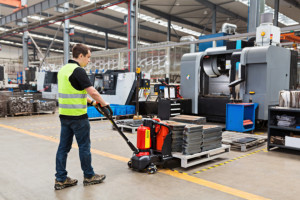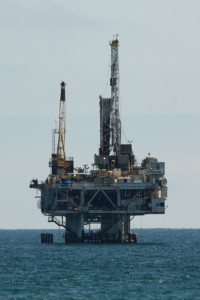 Pull production is a highly useful tool in manufacturing, logistics, services, and other industries. However, there are instances where pull may be not the best option. These instances are rare, but they do exist. In this blog post I will list different cases when pull may not be the best option.
Pull production is a highly useful tool in manufacturing, logistics, services, and other industries. However, there are instances where pull may be not the best option. These instances are rare, but they do exist. In this blog post I will list different cases when pull may not be the best option.
Recap: Pull Is a Limit on the WIP
 Pull systems overall are very robust and stable, well suited for pretty much any production system. In fact, they can also be used outside normal industry (e.g., in healthcare, military, call centers, banking, data processing, and other service industries). See my post Why Pull Is So Great! for more. However, many people define pull incorrectly. For me, pull is a fixed limit on the number of parts or jobs in the system. I wrote about it extensively in my post on The (True) Difference Between Push and Pull.
Pull systems overall are very robust and stable, well suited for pretty much any production system. In fact, they can also be used outside normal industry (e.g., in healthcare, military, call centers, banking, data processing, and other service industries). See my post Why Pull Is So Great! for more. However, many people define pull incorrectly. For me, pull is a fixed limit on the number of parts or jobs in the system. I wrote about it extensively in my post on The (True) Difference Between Push and Pull.
Don’t Pull If You Have No Control on the Number of Parts Arriving

Pull limits the number of parts in your system. Hence, one key requirement for doing pull is to control the number of parts entering your system. If you can’t do that, then you simply can’t pull.
In manufacturing, you usually have control over the number of parts arriving. Parts arrive only when you explicitly order or produce them. Without a purchase or production order, you won’t get any parts. Thus, you can limit the maximum inventory simply by not ordering or producing more when you reach that limit.

A counterexample would be retail, a repair store, or a key-copying location. A typical store usually has no influence on when a customer shows up. They usually cannot really limit the number of customers in the store unless they want to get bad reviews. Instead, if multiple customers arrive, the customer has to wait. If very few customers arrive, the staff has to wait. There is no defined limit on the upper number of customers.
 Of course, at one point you will hit a limit where you can’t physically fit any more customers in the store. But this is usually way past any sensible workload or even way past any fire regulations, although this happens annually on Black Friday.
Of course, at one point you will hit a limit where you can’t physically fit any more customers in the store. But this is usually way past any sensible workload or even way past any fire regulations, although this happens annually on Black Friday.
Don’t Pull If It Is Very Expensive to Turn Off Your Process

Another case against pull is if it is very expensive or impossible to turn off the process. Even if the customer purchases less, you may have to produce and build up inventory to avoid the even larger expense of shutting down your process.

This may happen in blast furnaces for steel smelting. Conventional wisdom is to turn on the furnace and then run it for twenty years without a break, until the inner lining is getting too thin and needs to be replaced. Stopping and restarting this process is very expensive, and companies try to avoid this.
Another example may be oil platforms, where the main cost is setting up the platform and drilling a hole. Once the platform is running, it often makes economic sense to keep operating even if the demand and the oil price goes down.
Don’t Pull If You Can Outperform a Pull System

Finally, pull may be inferior if you have a very high level of control of your system and an excellent knowledge of upcoming fluctuations (i.e., you are close to all-knowing and all-seeing in your production system). Even then, pull would still work.
However, it is imaginable to have a push-type system that outperforms a pull system if you have such an excellent understanding of your system. A pull system reacts immediately whenever a part is consumed or completed. A push system controlled by humans, computer logic, or artificial intelligence has to be able to outperform pull systems, giving either a better availability (for make-to-stock) or better utilization (for make-to-order) for the same inventory, or having a lower inventory for the same availability or utilization, or a combination of those.
Hence, if the knowledge of the human, computer logic, or AI of future fluctuations and disruptions is exceptional, they may be able to push a production system better than pull production. Yet, I believe such companies are as rare as unicorns. While you can occasionally meet a manager who believes his organization is all-knowing (usually in the higher ranks far removed from the shop floor), it is not true.
Other than that, I am always hard-pressed to find good examples where pull is not superior to push. In literature, you can find many scientific articles that claim push is better in some cases, but if you dig deeper, you will find that they just did not understand what pull actually is. Pull is much better at handling uncertainty and faster at maintaining your inventory buffer. Hence, the only case where push may be better is a highly stable system where you have an excellent understanding of the processes or of the expected fluctuations.
The common approach is usually to let pull do the day-to-day control, and human workers adjust the pull system if they know of an upcoming fluctuation. These could be seasonal demand changes, or your ship with goods just sunk, or all your products failed the safety test and need to be remade, or there is a craze for your products just because Beyoncé said she loves them, or your products sit like lead on the shelves just because Beyoncé said she hates them, or … or … or … I am sure you are familiar with many such examples in your industry.
Summary
Overall, pull is, in my view, still the best solution for almost all cases, providing an easy-to-use system that requires little intervention except for the occasional updates. There are very few exceptions where pull is inferior, as mentioned above. Now, go out, see where you can pull and where not, and organize your industry!

Once again, a very nice articulation of Push and Pull, Chris. Thanks!
Not trying to make an argument for pull being inferior, but isn’t rate based or level schedule replenishment a push system using the inventory cap definition? Have heard persuasive anecdote that “the same quantity at the same time every day” can be very beneficial for productivity due to its impact on stability / predictability / learning curve so can be superior when demand levels are very high and similarly stable.
To embellish, echo, re-state..ect..:
1. Flow wherever you can (while still pushing)
2. Produce to the TAKT (while still pushing)
And, only then do you, (actually earn the right to):
3. Implement a pull system
Great website & posts!
When you have high variability in some procurement or manufacturing steps you may still continue to use “Pull” as long as you protect the Value Stream with buffers. If buffers become too large this “Pull” will start looking more like “Push”.
Also when the lead time requested by your customer is much smaller than the procurement and manufacturing lead time you may need to use “Push” at least in part of the Value Stream.
I don’t understand what you mean by the implication that a store would somehow want to “pull” customers?
“A typical store usually has no influence on when a customer shows up. They usually cannot really limit the number of customers in the store unless they want to get bad reviews…”
Thanks for your post again Chris. A few remarks from my side on some details.
– No control on parts arriving
I have worked in some of these environments (re-manufacturing of copiers with unknown yield, processing and distribution of flower bulbs with unknown yield) and what you could do is define a decoupling point for the influx. But downstream of this point you can still pull.
– Furnaces:
I developed pull in such an environment (aluminum manufacturing) and it is very well possible. You can pull using sufficient end-of-line stock to overcome fluctuations. Besides, my experience is that the complexity is more how to respect or technical constraints (batch sizes, specific sequence) in pull than it is to keep them running.
Shops:
– When you cannot influence the influx of customers (although they are currently doing so – they pull them in using a cap on carts for instance), most shops, of course, vary capacity based upon the number of clients in the store.
What I was taught from my sensei was:
Flow where you can.
Pull where you can’t.
Never Push.
The implication is that Flow is a higher order of a system than Pull. This took me a long time to grasp because my interpretation was that Pull was a part of Flow. In a sense this is true. Flow is the state of Pull that is achieved when a process is 100% flexible. In other words, you don’t have to be “all knowing” if your process can handle whatever is thrown at it. Once a process has zero changeover time between all products it will make, there is no necessity for any WIP between the processes. The concept of taking a part that will be replaced by an identical part (pull) goes away.
Entire businesses rarely achieve Flow but it is pretty common for two process steps to be able to implement Flow instead of Pull. A manufacturing cell where the parts never get set down is actually demonstrating Flow, not Pull. This is the real goal as it is the state closest to zero waste. Pull is the countermeasure needed when this is yet to be achieved.
Popular museums and night clubs cap the number of customers inside. They don’t let a new one in until one comes out. With COVID-19, our local grocery supermarkets are doing it too. There is a line to get in but almost none at the check stands. It also works with jobs in a job-shop. They all have different routings and you don’t try to regulate the flows inside but, by capping the total number of jobs in progress, you mitigate congestion.
Excellent Discussion!!! Many thanks to all the commenters! I agree that you can decouple the “Push” part from the “pull” part through an inventory.
As for the store example: In pre-CORONA times, it was possible highly unusual for a store to limit the number of customers allowed. But I also agree that it is possible (as we are seeing now in many countries to reduce the spread of the pandemic). A store would theoretically benefit from a Pull system, as a too crowded store may impact the efficiency of the salespeople. If the customers and staff have trouble moving through the crowds, all processes become slower. On the other hand, of course, sending customers away is not good or the image, either.
As for the Oil Rig: Some oil producers (for oil sands deposits) literally heat up the underground to liquefy tar for extraction. Letting this cool down only to heat it up again later is a major cost factor, and also may permanently reduce the output of the well. But again, through decoupling it is possible to have Pull afterwards.
But again, excellent discussion and many thanks to everybody for contributing!
Acredito que tanto push quanto o pull podem ser utilizados, ora um ora outro, dependendo da dinâmica do processo.
[translation by editor: I believe that both push and pull can be used, now and then, depending on the dynamics of the process.]